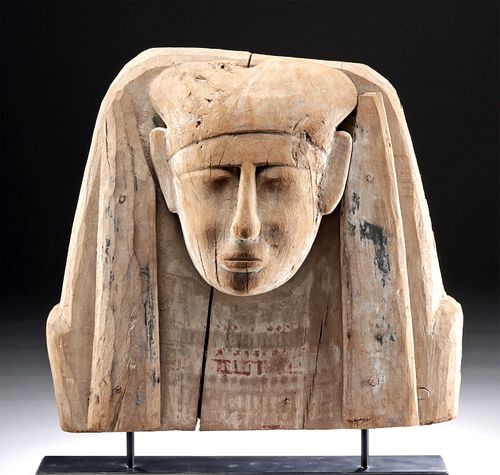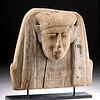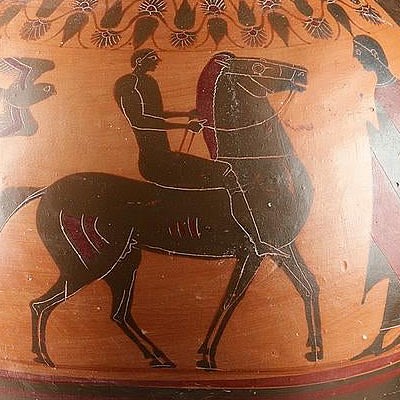Egyptian Painted Gesso Sarcophagus Head Panel
Lot 11a
About Seller
Artemis Gallery
686 S Taylor Ave, Ste 106
Louisville, CO 80027
United States
Selling antiquities, ancient and ethnographic art online since 1993, Artemis Gallery specializes in Classical Antiquities (Egyptian, Greek, Roman, Near Eastern), Asian, Pre-Columbian, African / Tribal / Oceanographic art. Our extensive inventory includes pottery, stone, metal, wood, glass and textil...Read more
Estimate:
$8,000 - $12,000
Absentee vs Live bid
Two ways to bid:
- Leave a max absentee bid and the platform will bid on your behalf up to your maximum bid during the live auction.
- Bid live during the auction and your bids will be submitted real-time to the auctioneer.
Bid Increments
| Price | Bid Increment |
|---|---|
| $0 | $25 |
| $300 | $50 |
| $1,000 | $100 |
| $2,000 | $250 |
| $5,000 | $500 |
| $10,000 | $1,000 |
| $20,000 | $2,500 |
| $50,000 | $5,000 |
| $100,000 | $10,000 |
| $200,000 | $20,000 |
About Auction
By Artemis Gallery
Jun 4, 2020
Set Reminder
2020-06-04 10:00:00
2020-06-04 10:00:00
America/New_York
Bidsquare
Bidsquare : Exceptional Antiquities, Asian, Ethnographic
https://www.bidsquare.com/auctions/artemis-gallery/exceptional-antiquities-asian-ethnographic-5185
An important one-day auction featuring museum-worthy examples of Egyptian, Greek, Roman, Etruscan, Near Eastern, Far East / Asian, Pre-Columbian, African / Tribal, Oceanic, Native American, Spanish Colonial, Russian, Fossils, Ancient Jewelry, Fine Art, so much more! Artemis Gallery info@artemisgallery.com
An important one-day auction featuring museum-worthy examples of Egyptian, Greek, Roman, Etruscan, Near Eastern, Far East / Asian, Pre-Columbian, African / Tribal, Oceanic, Native American, Spanish Colonial, Russian, Fossils, Ancient Jewelry, Fine Art, so much more! Artemis Gallery info@artemisgallery.com
- Lot Description
Egypt, Late Dynastic period, 26th to 31st Dynasty, ca. 664 to 332 BCE. A gorgeous face section of a hand-carved wooden sarcophagus panel with a flat backing. Centered on the panel is a wooden mummy mask with a serene countenance defined by bulging ovoid eyes, a slender nose that flares lightly at the nostrils, tall cheeks flanking full lips above a rounded chin, and tab-shaped ears, all beneath a simple cap that sits low on the smooth forehead. Both wig lappets are draped to the sides of the head and bear traces of black-painted gesso, and the chest still retains the soft details of the red-painted broad pectoral collar. Traces of six wooden dowels are visible in their original holes across the front, with several more observable on the verso. An elegant and sophisticated example of ancient Egyptian funerary tradition! Size: 19" W x 16.875" H (48.3 cm x 42.9 cm); 19.4" H (49.3 cm) on included custom stand.
Ancient Egyptians believed it was of the utmost importance to preserve a body of the deceased, because the soul needed a place to reside after the death. Preservation of the body was done via mummification - a process involving the removal of internal organs that were placed in canopic jars, wrapping the body in linen, and then embalming. Death masks and sarcophagus panels like this example were created so that the "ba" - the part of the soul that left the body each day - could recognize their old form body and become rejoined each evening with the "ka" - the part of the soul that permanently stayed with the body.
Provenance: private J.H. collection, Beaverton, Oregon, USA, acquired in 2002; ex-Tom Cederlind collection, Portland, Oregon, USA
All items legal to buy/sell under U.S. Statute covering cultural patrimony Code 2600, CHAPTER 14, and are guaranteed to be as described or your money back.
A Certificate of Authenticity will accompany all winning bids.
We ship worldwide and handle all shipping in-house for your convenience.
#151087Backing repaired from two large pieces, with stabilization material along break lines on verso. Face mask is of a similar age as backing but is not original to backing. Nicks, abrasions, and stable fissures to backing and mask, with fading to most original painted gesso, and desiccation commensurate with age. Great traces of original painted gesso across obverse.Condition
- Shipping Info
-
All shipping is handled in-house for your convenience. Your invoice from Artemis Gallery will include shipping calculation instructions. If in doubt, please inquire BEFORE bidding for estimated shipping costs for individual items.
-
- Buyer's Premium



 EUR
EUR CAD
CAD AUD
AUD GBP
GBP MXN
MXN HKD
HKD CNY
CNY MYR
MYR SEK
SEK SGD
SGD CHF
CHF THB
THB













